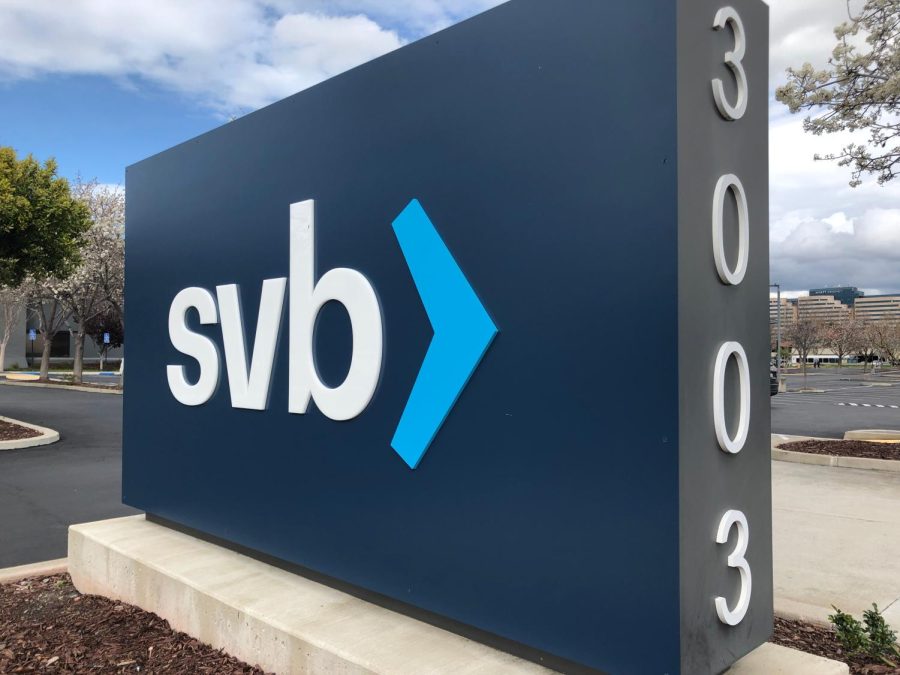Silicon Valley Bank Folds
What happened with Silicon Valley Bank, and how does it affect you?
The monument sign in front of the parking lot of the Silicon Valley Bank headquarters at 3003 West Tasman Drive, Santa Clara, California. Wikimedia Commons.
On March 10th, a bank run took place at Silicon Valley Bank, when many of the bank’s clients withdrew their money for fear of losing it if the bank collapsed. The bank had invested heavily in bonds—a kind of investment where you invest a fixed amount in a company, and they pay you back at a set time. When the Federal Reserve raised interest rates, the value of those bonds fell heavily.
Usually, this wouldn’t be a problem unless the bank was forced to sell the bonds. However, due to mismanagement of their funds, deposits started leaving the bank faster than anticipated. During the pandemic, Silicon Valley Bank received nearly triple the deposits it had in previous years while not scaling its management accordingly. When investors wanted to withdraw their money, Silicon Valley needed more cash on hand and were forced to sell off their bonds at a significant loss. As a result, more people began withdrawing their money, worried it wouldn’t be safe in the bank.
The collapse of Silicon Valley Bank also led to the shutdown of Signature Bank due to concerns over depositors withdrawing large amounts of money from that bank after the failure of Silicon Valley Bank. The event snowballed into one of the largest bank runs in history, with approximately $42 billion in combined assets lost.
Usually, the federal government insures a depositor’s money up to $250,000 in case of a bank failure, so the average person has their money guaranteed. The $250,000 cap also applies to large businesses where most have well over this amount. However, the U.S. Treasury Department said it would ensure all depositors beyond the $250,000 limit and that they would be able to access their funds by the next day.
Bank runs like this significantly affect people’s everyday lives in many ways. The first is that, like with Signature Bank, more banks could have been shut down in a chain reaction of bank runs. When more banks shut down, it could result in widespread bank holidays, making it difficult for individuals to access their funds for daily expenses, bill payments, or emergencies.
In addition to the direct consequences of bank closures, the broader economic impact of these events can also be widespread. Instability in the banking sector can lead to reduced lending and tightened credit conditions, hampering business growth and investment. This, in turn, can result in job losses, wage stagnation, and a slowdown in overall economic growth, making it harder for individuals to find employment or achieve financial stability. The potential for additional bank runs, economic slowdowns, and strained public resources highlights the importance of maintaining a robust and transparent financial system to mitigate such crises’ impact on the general public.
The financial turmoil created by the collapse of Silicon Valley Bank and the subsequent bank run at Signature Bank also has implications for the stock market and investment portfolios. As investors lose confidence in the financial system’s stability, stock markets may experience heightened volatility, with significant fluctuations in share prices. This could lead to substantial losses for individual investors, particularly those nearing retirement or relying on investment income to meet their financial needs as pension funds and may also suffer from the downturn in the stock market. The repercussions of these events can extend to global financial markets, with investors worldwide becoming more cautious. This heightened risk aversion can impact international trade, investment, and economic growth, leading to a potential global economic slowdown. In this scenario, job opportunities, wage growth, and living standards may be adversely affected in the United States and worldwide.
The events surrounding Silicon Valley Bank and Signature Bank underscores the interconnectedness of modern financial systems and the potential for localized crises to have wide-ranging consequences. Therefore, regulators, policymakers, and financial institutions must work together to maintain a stable and resilient financial system, ensuring that people can undertake such crises with minimal disruption to their lives and livelihoods.

While being one of the initiative leaders for the Advocate’s podcast division, The Podvocate, Isaiah ’24 is also a writer for The Advocate who has...







